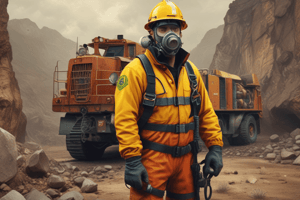Podcast
Questions and Answers
What is the minimum notice period required for withdrawal from the Mine Ban Treaty?
What is the minimum notice period required for withdrawal from the Mine Ban Treaty?
- Unlimited
- 1 year
- 3 months
- 6 months (correct)
What was the outcome of the Oslo Diplomatic Conference on a Total Global Ban on Anti-Personnel Mines in 1997?
What was the outcome of the Oslo Diplomatic Conference on a Total Global Ban on Anti-Personnel Mines in 1997?
- 116 states rejected the treaty
- 87 states signed the treaty
- 157 countries attended the conference
- 89 states adopted the text (correct)
Which of the following organizations worked in partnership with a core group of states to ban landmines?
Which of the following organizations worked in partnership with a core group of states to ban landmines?
- Amnesty International and the United Nations
- Human Rights Watch and the Geneva Conventions
- Doctors Without Borders and the World Health Organization
- The International Committee of the Red Cross and the International Campaign to Ban Landmines (correct)
How many countries have signed the Convention on the Prohibition of the Use, Stockpiling, Production and Transfer of Anti-Personnel Mines and on their Destruction?
How many countries have signed the Convention on the Prohibition of the Use, Stockpiling, Production and Transfer of Anti-Personnel Mines and on their Destruction?
When did the Convention on the Prohibition of the Use, Stockpiling, Production and Transfer of Anti-Personnel Mines and on their Destruction enter into force?
When did the Convention on the Prohibition of the Use, Stockpiling, Production and Transfer of Anti-Personnel Mines and on their Destruction enter into force?
What is the name of the treaty that was adopted in 1997?
What is the name of the treaty that was adopted in 1997?
What is the main goal of the United States in regards to the Ottawa Convention?
What is the main goal of the United States in regards to the Ottawa Convention?
What is the total number of states that have signed or ratified the Treaty on the Prohibition of Nuclear Weapons (TPNW)?
What is the total number of states that have signed or ratified the Treaty on the Prohibition of Nuclear Weapons (TPNW)?
What is the main focus of Article 1 of the Treaty on the Prohibition of Nuclear Weapons (TPNW)?
What is the main focus of Article 1 of the Treaty on the Prohibition of Nuclear Weapons (TPNW)?
Which of the following states have not joined the Treaty on the Prohibition of Nuclear Weapons (TPNW)?
Which of the following states have not joined the Treaty on the Prohibition of Nuclear Weapons (TPNW)?
What is the purpose of Article 2 of the Treaty on the Prohibition of Nuclear Weapons (TPNW)?
What is the purpose of Article 2 of the Treaty on the Prohibition of Nuclear Weapons (TPNW)?
When did the Treaty on the Prohibition of Nuclear Weapons (TPNW) enter into force?
When did the Treaty on the Prohibition of Nuclear Weapons (TPNW) enter into force?
What is the primary goal of stigmatizing nuclear weapons?
What is the primary goal of stigmatizing nuclear weapons?
Why did the Cold War hinder efforts to stigmatize nuclear weapons?
Why did the Cold War hinder efforts to stigmatize nuclear weapons?
According to Nina Tannenwald, what has been growing with respect to nuclear weapons?
According to Nina Tannenwald, what has been growing with respect to nuclear weapons?
What is the limitation of stigmatizing only nuclear weapons?
What is the limitation of stigmatizing only nuclear weapons?
What is the perspective of nuclear-weapon proponents regarding stigmatization?
What is the perspective of nuclear-weapon proponents regarding stigmatization?
What is the primary difference between the stigma on the use and possession of nuclear weapons?
What is the primary difference between the stigma on the use and possession of nuclear weapons?
What is a characteristic of nuclear weapons that paradoxically supports their use as a deterrent?
What is a characteristic of nuclear weapons that paradoxically supports their use as a deterrent?
What is the focus of the article in relation to weapons of mass destruction?
What is the focus of the article in relation to weapons of mass destruction?
Why are nuclear weapons considered the most destructive weapon systems ever invented?
Why are nuclear weapons considered the most destructive weapon systems ever invented?
What is the concept that has been introduced to a wider range of research areas, including international relations, and is relevant to the study of nuclear weapons?
What is the concept that has been introduced to a wider range of research areas, including international relations, and is relevant to the study of nuclear weapons?
What is the connection that Jeffrey Chwieroth has examined in his research?
What is the connection that Jeffrey Chwieroth has examined in his research?
What is necessary for nuclear-armed states to be prone to stigma and stigmatization?
What is necessary for nuclear-armed states to be prone to stigma and stigmatization?
What is the effect of the ban treaty, according to the advocates of the humanitarian initiative?
What is the effect of the ban treaty, according to the advocates of the humanitarian initiative?
What is the significance of the 2010 Final Document of the 2010 NPT Review Conference?
What is the significance of the 2010 Final Document of the 2010 NPT Review Conference?
What is the current stance of the majority of states in the world regarding nuclear weapons?
What is the current stance of the majority of states in the world regarding nuclear weapons?
What is the prerequisite for the stigmatization of nuclear weapons?
What is the prerequisite for the stigmatization of nuclear weapons?
What is the goal of the advocates of the humanitarian initiative regarding nuclear weapons?
What is the goal of the advocates of the humanitarian initiative regarding nuclear weapons?
What is a common trend among states that are not parties to the MBT?
What is a common trend among states that are not parties to the MBT?
What is the impact of social pressures on states that remain outside of the MBT?
What is the impact of social pressures on states that remain outside of the MBT?
What is the attitude of resistant states towards the ban on AP landmines?
What is the attitude of resistant states towards the ban on AP landmines?
What is the significance of the humanitarian discourse in the context of disarmament policy?
What is the significance of the humanitarian discourse in the context of disarmament policy?
What is the relationship between national interests and moral values in the formulation of state policy?
What is the relationship between national interests and moral values in the formulation of state policy?
What is the implication of the fact that most non-parties to the MBT have endorsed the humanitarian goals of the ban?
What is the implication of the fact that most non-parties to the MBT have endorsed the humanitarian goals of the ban?
What is the significance of states signaling their support for humanitarian norms, despite arguing that domestic conditions preclude earlier accession?
What is the significance of states signaling their support for humanitarian norms, despite arguing that domestic conditions preclude earlier accession?
What is the role of normative discourse in the context of disarmament policy?
What is the role of normative discourse in the context of disarmament policy?
What is the relationship between the humanitarian purpose of the Mine Ban Treaty and the legitimacy of the treaty among its supporters?
What is the relationship between the humanitarian purpose of the Mine Ban Treaty and the legitimacy of the treaty among its supporters?
How do states' actions of signaling support for humanitarian norms, despite arguing that domestic conditions preclude earlier accession, impact the universalization of treaties?
How do states' actions of signaling support for humanitarian norms, despite arguing that domestic conditions preclude earlier accession, impact the universalization of treaties?
What is the significance of the Mine Ban Treaty in the context of global governance?
What is the significance of the Mine Ban Treaty in the context of global governance?
What is the role of human rights advocacy in the context of disarmament policy and treaty universalization?
What is the role of human rights advocacy in the context of disarmament policy and treaty universalization?
Flashcards are hidden until you start studying
Study Notes
Mine Ban Treaty
- The Mine Ban Treaty, also known as the Ottawa Treaty, was opened for signature on December 3, 1997, and entered into force on March 1, 1999.
- The treaty has 164 State Parties and 33 non-State Parties.
- Key provisions of the treaty include:
- Article 1: General obligations
- Article 6: International cooperation and assistance
- Article 7: Transparency measures
- Article 8: Facilitation and clarification of compliance
- Article 9: National implementation measures
- Article 10: Settlement of disputes
- Article 11: Meetings of the State Parties
- Article 12: Review Conferences
- Article 13: Amendments
- Article 14: Costs
- Article 19: Reservations (none allowed)
- Article 20: Duration and withdrawal (unlimited; withdrawal with 6 months' notice, but not during armed conflict)
Allegations of Use
- Recent allegations of use of landmines include:
- Ukraine, a State Party, in 2022 (President of the Anti-Personnel Mine Ban Convention states that it will use established procedures to seek clarification of allegations)
- Russia, a non-State Party (report by Human Rights Watch, 29 March 2022)
- Myanmar, a non-State Party (report by Amnesty International, 20 July 2022)
Treaty on the Prohibition of Nuclear Weapons (TPNW)
- The TPNW was opened for signature on September 20, 2017, and entered into force on January 22, 2021.
- The treaty has 70 State Parties and 23 signed but not ratified.
- Key provisions of the treaty include:
- Article 1: Prohibitions (covering development, testing, production, manufacture, acquisition, possession, stockpiling, use, or threats of use, as well as stationing, installing, or deployment of nuclear weapons or nuclear explosive devices)
- Article 2: Declarations of prohibited activities prior to entry into force or currently
- Article 3: Safeguards (if Article 4 does not apply, must at a minimum maintain or conclude a comprehensive safeguards agreement with the IAEA)
Stigma and Nuclear Weapons
- The concept of stigma has been introduced to a wider range of research areas, including international relations.
- Stigma research has a tradition in sociological and medical studies, especially concerning mental illness and HIV/AIDS.
- The article questions whether the stigma of nuclear weapons may impact the nuclear policies of nuclear-armed states and, as a result, may accelerate the process toward nuclear-weapon elimination.
- The humanitarian initiative and the resulting TPNW could further alter the paradigm on nuclear weapons, changing them from a symbol of prestige to a "discrediting attribute."
- Through their actions, the pressure from citizens on their governments within the nuclear-armed states may increase.
Studying That Suits You
Use AI to generate personalized quizzes and flashcards to suit your learning preferences.




